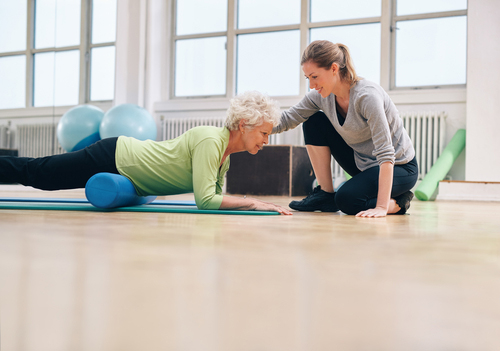If you are a gym rat and have been for the past decade, you’ve noticed a change in the gym. People have been starting to use this weird roller and grimacing while sitting on it. You are probably aware of the name of this practice: foam rolling or self myo-fascial release (SMR). But why are people doing it if it hurts so much?
WHAT IS FOAM ROLLING?
- Foam rolling, or SMR, is a fancy term for self massage to release muscle tightness or trigger points. It can be performed with rollers, Theracane, trigger point balls or even your bare hands.
- Trigger points are “knots” (a bunch of overactive muscle fibres) that can be found in the muscle. It is very easy to find them: they hurt under pressure. A common example is the tenderness you feel when you put pressure on some specific area of your IT band (side of your thigh).
WHY SHOULD YOU SPEND TIME ON THE ROLLER?
There are many reasons why, here are the most common:
- foam rolling can assist in releasing trigger points and breaking up adhesions and scar tissue.
- foam rolling increases the blood flow in the muscle.
- foam rolling forces the muscle to relax. It stops the overactive muscle from starting the movement and allowing the under-firing muscle to work properly. This gives you a short window of time where you can teach your body a proper movement pattern. As you probably guessed, this is my favourite reason. An example would be the client that performs push-ups with a shoulder shrug: chances are the upper trapezius are overactive, and start before the rhomboids can kick in, releasing the upper traps with SMR and stretching allow you to perform a proper push up (article coming soon).
- I like to use rolling as a compliment to stretching. Imagine an elastic band with a knot in the middle, if you pull on it, the elastic stretches but the knot doesn’t. Foam rolling allows you to “untie” the knot before stretching, making your stretching session more efficient.
HOW NOT TO DO IT
- do not simply roll back and forth. It takes longer to get the relaxation that you are going for
- Make sure not to roll the same body part every day: you will be rolling your muscle/tendon to a pulp, creating dysfunction, and increasing the chances of injury.
HOW TO DO IT
There are two techniques that I like to use:
- find a tender spot and hold for a while (usually 30 seconds). You want to hold the tender spot until the pain disappears. I don’t like to give a number because it adds tension/stress to a practice that is designed to actually relax you. I like to tell my clients to breathe deeply while rolling, inhale through the nose, and exhaling completely through the mouth. This helps with the relaxation. The more relaxed you are, the quicker the pain will go.
- find a tender spot, and then stretch/contract the muscle. This is a more “aggressive” technique. Yes, it is my pick! One example of this method is rolling your quads (front of the thigh), then curling the leg as you would do in a hamstring curl 3 times.
A few muscles that could typically use some SMR love:
- Calves
- Quads
- Hip external rotators
- Lats
- Rhomboids
- Pecs
Let’s recap:
- make sure you spend some time rolling before or after your work out, it can really help you stay injury free
- roll out different muscle groups, and make sure you don’t always do the same spot.
- do some stretching after to make sure the knot is completely released

